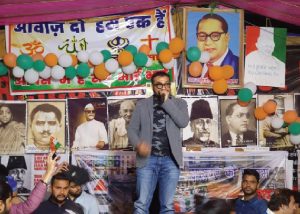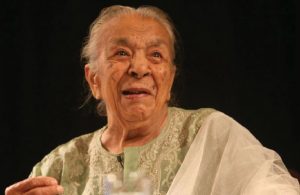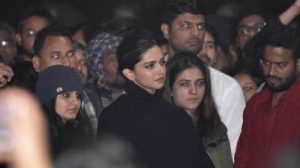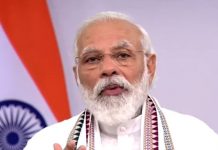 Strange it seems that allegations of rape and sexual misconduct against Bollywood’s Anurag Kashyap have come up at this juncture. Why now? Is it something or everything to do with his anti-CAA stand and his blatant criticism of the right-wing characters. If you recall, last winter he had even visited Jamia Millia campus and had also met the anti-CAA protesters at Shaheen Bagh. In fact, he is one of those who doesn’t mince words and has been very vocal about the policies of this government.
Strange it seems that allegations of rape and sexual misconduct against Bollywood’s Anurag Kashyap have come up at this juncture. Why now? Is it something or everything to do with his anti-CAA stand and his blatant criticism of the right-wing characters. If you recall, last winter he had even visited Jamia Millia campus and had also met the anti-CAA protesters at Shaheen Bagh. In fact, he is one of those who doesn’t mince words and has been very vocal about the policies of this government.
The way the hounding and arrest of the rebels is on, it seems many more could be targeted. Even the silent sympathisers could face tough times. You must have noticed that from the last couple of days, ever since her name has come up with the allegation of drugs intake, the photographs of Deepika Padukone that are getting played up on the small screen are the ones that were clicked when she had visited the Jawaharlal Nehru University campus …she was there last winter, just days after several students of that university were targeted and assaulted by right-wing goons. She hadn’t come up with a speech nor with a statement but her visiting the campus and standing in the midst of the students relayed solidarity and much more along the strain.
Don’t know what would remain of Bollywood, with politics more than intruding, spreading its fangs. It is getting obvious that the right-wing lobbies are trying to come centre-stage. Till date Bollywood was supposedly one of those spheres that had managed to keep the hawks somewhat away from its terrain. But now ground realities don’t look too good. Will the aftermath of the agenda, unfolding right in the midst of the Bollywood, get too divisive and frightful for us to see! What will be in store for the movers and shakers of Bollywood!
♦ ♦ ♦
In fact, the first time I ‘d realised the huge impact of Bollywood’s movers and shakers, not just in our country but far beyond, was years back in 1995 , when I’d interviewed Surat Mirkasymov — he was Uzbekistan’s very first ambassador to India.
I was taken aback not just by the fluent Hindustani that Surat Mirkasymov spoke but also by his knowledge of Bollywood films and those film stars. Before I got down to interviewing him about his country and the diplomatic ties between his country and India (that was to be the thrust of this interview) I had to settle those ‘whys’ hitting my head. I had to ask him the ‘why’ to his fluent Hindustani , his love for Bollywood film and filmstars.
With that the Uzbek ambassador offloaded a tale; on which a full-fledged feature film could be made. Let me start off by writing those details to what he kept offloading, in between eating dried apricots — “These apricots are from our Farghana Valley … My love for Hindustani language. Why? Learnt it, mastered it because of my love for your country’s cinema …Actually whilst I was still in school (Tashkent’s famous school No .24, which was later named after Lal Bahadur Shastri), the city had some special visitors. This was around 1954 when Pandit Jawaharlal Nehru had sent a delegation of film stars — Nargis, Raj Kapoor, Dev Anand and several others, to the first film festival of India in Tashkent. And several movies were screened — Awaara, Baiju Bawra, Do Beegha Zameen …you can’t imagine how I felt when I saw these stars and their films .I can’t describe what I felt .Yes, something happened to me!”
With that take-off, Surat Mirkasymov used his Taurean determination to master the languages — Hindi and Urdu, so that he could grasp details to our films and the filmi world. “Yes, I was absolutely determined to master these two languages, Urdu and Hindi .And so just after my schooling, I enrolled at the newly opened Oriental Faculty of the Tashkent University. But then there was a major hitch. There was no teacher to be found in the whole of Tashkent who could teach us Urdu and Hindi …Finally , one day we were told that there was an Indian prisoner lodged at Tashkent’s Central Jail who could teach us. And he was academic-scholar Madan Mohan Hardat and an expert on these languages. After he was freed from jail, he became our guru and it’s only because of him I could master these two languages.”
He had also gone to explain why Madan Mohan Hardat was lodged in Tashkent Jail. “There is this sad and strange story about how he was languishing in our jail …He was a well -known scholar from the Banaras Hindu University and during the Freedom Struggle he wanted to come to the USSR to learn more on how to go about the freedom movement but whilst he was crossing the Afghanistan-USSR border, he was caught and mistaken for a spy and with that dumped in the Tashkent Jail. Of course, later he was freed us and taught us. He returned to India in 1961 but died unsung in 1985.”
Getting back to his love for Indian cinema, Surat Mirkasymov told me that after passing out from the university he worked for Radio Tashkent for five years, from 1962-1967 , for the Hindi -Urdu service. Then he worked as a translator. And then headed the Uzbek Society for Cultural Relations with foreign countries. This followed his first diplomatic posting to India, serving as Secretary in the Soviet Embassy here in New Delhi and then later in 1971, when he became USSR’s Consul General in Calcutta. After the Soviet Union broke up and Uzbekistan became an independent country, he was back in India.This time as his country’s very first envoy to India.
I had also asked him: Did he get to meet any of the stars he ‘d been attracted to? “It was a big list/bahut badi list hai …there’s Rekha, Waheeda …and today my favourite film is 1942: A Love Story … Manisha Koirala seems a nice girl …”
Did he see our films regularly? “On the small screen …today, though even our film industry is very big but till date your country’s films are very popular in our country .Your country’s films are really loved by our people … because of this love for your films, our people really respect Indians; so much so that if they spot a lady wearing a sari they will invite her home for tea.”
And this Indologist was planning to use his mastery over Urdu and Hindi to translate Mughal Emperor Babar poems and memoir into Hindustani.
To quote him, “Babar was one of the greatest poets of our land and his poems and Babarnama should be read by more and more people , for then they’d realize his genuine feelings for this land and for Indians. Babar was not a destroyer but a creator. If you read about his entire life you’d realize he created, whether poetic verse or even when he created the Mughal empire here, he got/ transported trees, flowers, plants, fruits, cuisine, architectural stuff all the way from Uzbekistan. It is unfortunate that he is known only as a conqueror though there are different aspects to his personality. Babar wrote in his Babarnama this message for his son Humayan: Cow-slaughter should never be allowed to take place in this land, for it will hurt the feelings of the Hindus.”
♦ ♦ ♦
Google Doodle honours Zohra Segal!
 On September 29, Google honoured Zohra Segal. After all, her film Neecha Nagar was released at the Cannes Film Festival on that day in 1946. Seeing her up there, got me in that introspective mood. Kept thinking of the two earlier occasions when I’d interviewed the actress and theatre personality Zohra Segal. What had impressed me was her spontaneity and her tendency to offload. Telling details about her personal life, along the dastangoi/story telling strain.
On September 29, Google honoured Zohra Segal. After all, her film Neecha Nagar was released at the Cannes Film Festival on that day in 1946. Seeing her up there, got me in that introspective mood. Kept thinking of the two earlier occasions when I’d interviewed the actress and theatre personality Zohra Segal. What had impressed me was her spontaneity and her tendency to offload. Telling details about her personal life, along the dastangoi/story telling strain.
Chatting informally as though we’d known each other for years, she didn’t shy away from narrating those financial lows she’d been through after her husband Kamleshwar Segal had killed himself. His death had left her and her children traumatised. And it was Jawaharlal Nehru who helped her at that very crucial juncture of her life and career.
Thereafter, she left Mumbai to re-establish herself in the UK, only to return… Starting off another long phase of work, struggle and more of those turns and twists. In fact, details and those turns and twists in her life have been webbed in the book on her. Written by her daughter Kiran, titled Zohra Segal: Fatty (Niyogi Books). This book was launched in 2012.
 A trained classical Odissi dancer and artist Jatin Das’ former spouse, Kiran has done an excellent job of putting together her all those ups and downs in her mother Zohra’s life …Let me quote her from the foreword to this book — “When someone asked me to write a book on my mother I wondered, ‘What can I write about her? She is my mother and that’s it.’ Most important, I am not a writer. I can only dance and nothing else! Then the seed was sown and I kept thinking about it as days went by. This was in 2006 — almost six years ago. My mind travelled in reverse gear to my childhood with her, my father Kamleshwar Segal and my brother Pawan, in 41 Pali Hill, Mumbai (then Bombay). What a happy family we were. Her strictness, my father’s laughter, the get-togethers with the neighbours, my friends and I running all over the place, going to school and of course to Prithvi Theatres with her. My first dance lessons and training were with my mother and I learnt a lot from watching her ‘dance’ …I have written this book not as a historian or as a experienced writer but as a daughter who has been with her mother throughout her mother’s ‘ups’ and ‘downs’, her struggle, her tragedies, and her several moods! My mother has also been a great friend to me .We’ve had our fights, disagreements and criticism of each other — more her than me – our jokes on ourselves and on others. It has been wonderful…On 27 April 2012, my mother Zohra Segal completes a hundred years of excitement in dance, theatre, films, television and this journey we call life. She exclaims, ‘I have hundred years of history in me!’ Congratulations, Ammi!”
A trained classical Odissi dancer and artist Jatin Das’ former spouse, Kiran has done an excellent job of putting together her all those ups and downs in her mother Zohra’s life …Let me quote her from the foreword to this book — “When someone asked me to write a book on my mother I wondered, ‘What can I write about her? She is my mother and that’s it.’ Most important, I am not a writer. I can only dance and nothing else! Then the seed was sown and I kept thinking about it as days went by. This was in 2006 — almost six years ago. My mind travelled in reverse gear to my childhood with her, my father Kamleshwar Segal and my brother Pawan, in 41 Pali Hill, Mumbai (then Bombay). What a happy family we were. Her strictness, my father’s laughter, the get-togethers with the neighbours, my friends and I running all over the place, going to school and of course to Prithvi Theatres with her. My first dance lessons and training were with my mother and I learnt a lot from watching her ‘dance’ …I have written this book not as a historian or as a experienced writer but as a daughter who has been with her mother throughout her mother’s ‘ups’ and ‘downs’, her struggle, her tragedies, and her several moods! My mother has also been a great friend to me .We’ve had our fights, disagreements and criticism of each other — more her than me – our jokes on ourselves and on others. It has been wonderful…On 27 April 2012, my mother Zohra Segal completes a hundred years of excitement in dance, theatre, films, television and this journey we call life. She exclaims, ‘I have hundred years of history in me!’ Congratulations, Ammi!”
letters@tehelka.com













